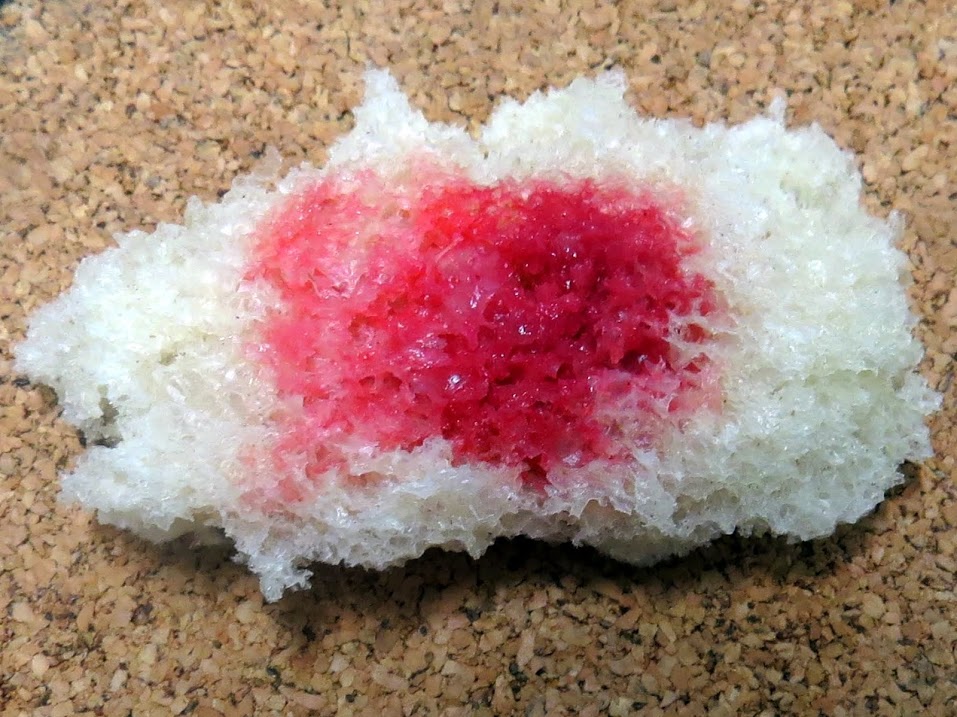Prodiginine on:
[Wikipedia]
[Google]
[Amazon]
 The prodiginines are a family of red tri
The prodiginines are a family of red tri
Prodigiosin colour.svg,
pyrrole
Pyrrole is a heterocyclic, aromatic, organic compound, a five-membered ring with the formula . It is a colorless volatile liquid that darkens readily upon exposure to air. Substituted derivatives are also called pyrroles, e.g., ''N''-methylpyrrol ...
dyestuff
Juan de Guillebon, better known by his stage name DyE, is a French musician. He is known for the music video of the single "Fantasy" from his first album ''Taki 183''. This video became popular, attracting over 65 million views, 49 million of t ...
s produced by Gammaproteobacteria
''Gammaproteobacteria'' is a class of bacteria in the phylum ''Pseudomonadota'' (synonym ''Proteobacteria''). It contains about 250 genera, which makes it the most genus-rich taxon of the Prokaryotes. Several medically, ecologically, and scienti ...
(e.g. ''Serratia marcescens
''Serratia marcescens'' () is a species of bacillus (shape), rod-shaped, Gram-negative bacteria in the family Yersiniaceae. It is a facultative anaerobe and an opportunistic pathogen in humans. It was discovered in 1819 by Bartolomeo Bizio in Pa ...
'') as well as some Actinomycetota
The Actinomycetota (or Actinobacteria) are a diverse phylum of Gram-positive bacteria with high GC content. They can be terrestrial or aquatic. They are of great importance to land flora because of their contributions to soil systems. In soil t ...
(e.g. ''Streptomyces coelicolor
''Streptomyces albidoflavus'' is a bacterium species from the genus of ''Streptomyces'' which has been isolated from soil from Poland. ''Streptomyces albidoflavus'' produces dibutyl phthalate and streptothricins.
Small noncoding RNA
Bacteri ...
''). The group is named after prodigiosin
Prodigiosin is a red dye produced by many strains of the bacterium ''Serratia marcescens'', as well as other Gram-negative, gamma proteobacteria such as ''Vibrio psychroerythrus'' and ''Hahella chejuensis''. It is responsible for the pink tint occ ...
(prodiginine) and is biosynthesized through a common set of enzymes. They are interesting due to their history and their varied biological activity
In pharmacology, biological activity or pharmacological activity describes the beneficial or adverse effects of a drug on living matter. When a drug is a complex chemical mixture, this activity is exerted by the substance's active ingredient or ...
.
Structural types
Prodigiosin
Prodigiosin is a red dye produced by many strains of the bacterium ''Serratia marcescens'', as well as other Gram-negative, gamma proteobacteria such as ''Vibrio psychroerythrus'' and ''Hahella chejuensis''. It is responsible for the pink tint occ ...
Cycloprodigiosin.svg, Cycloprodigiosin
Cyclononylprodigiosin.svg, Cyclononylprodigiosin
Undecylprodigiosin coloured.svg, Undecylprodigiosin
Butyl-meta-cycloheptylprodiginine.svg, Butyl-meta-cycloheptylprodiginine
Natural sources
The prodiginines aresecondary metabolite
Secondary metabolites, also called ''specialised metabolites'', ''secondary products'', or ''natural products'', are organic compounds produced by any lifeform, e.g. bacteria, archaea, fungi, animals, or plants, which are not directly involved ...
s originally noted in ''Serratia
''Serratia'' is a genus of Gram-negative, facultatively anaerobic, rod-shaped bacteria of the family Enterobacteriaceae. They are typically 1–5 μm in length, do not produce spores, and can be found in water, soil, plants, and animals. Some mem ...
'' species, especially ''Serratia marcescens''. They are also found in Actinomycetes
The Actinomycetales is an Scientific classification, order of Actinomycetota. A member of the order is often called an actinomycete. Actinomycetales are generally Gram-positive bacteria, gram-positive and anaerobic and have mycelia in a filamento ...
, for example ''Streptomyces coelicolor
''Streptomyces albidoflavus'' is a bacterium species from the genus of ''Streptomyces'' which has been isolated from soil from Poland. ''Streptomyces albidoflavus'' produces dibutyl phthalate and streptothricins.
Small noncoding RNA
Bacteri ...
'' and some marine bacteria, including '' Hahella chejuensis'' and '' Pseudoalteromonas denitrificans''. Cyclononylprodigiosin was isolated from Actinomadura species.
Chemistry
The Prodiginine family consists of primarily red-pigmented tripyrrole secondary metabolites.Production
Biosynthesis
Prodiginine, first extracted from terrestrial ''Serratia marcescens,'' consisted of a straight alkyl chain substituent and was named prodigiosin. The prodiginines are produced from a common intermediate, tambjamine aldehyde (also known as MBC, from its systematic name 4-methoxy-2,2'-bipyrrole-5-carboxaldehyde). This contains two pyrrole rings built fromproline
Proline (symbol Pro or P) is an organic acid classed as a proteinogenic amino acid (used in the biosynthesis of proteins), although it does not contain the amino group but is rather a secondary amine. The secondary amine nitrogen is in the p ...
and serine
Serine
(symbol Ser or S) is an α-amino acid that is used in the biosynthesis of proteins. It contains an α- amino group (which is in the protonated − form under biological conditions), a carboxyl group (which is in the deprotonated − ...
as shown in the blue-shaded pathway in Figure 1. The aldehyde
In organic chemistry, an aldehyde () (lat. ''al''cohol ''dehyd''rogenatum, dehydrogenated alcohol) is an organic compound containing a functional group with the structure . The functional group itself (without the "R" side chain) can be referred ...
is subsequently condensed with a third pyrrole to form prodigiosin (compound 16 in Figure 1), which is then further elaborated to cycloprodigiosin (compound 22 in Figure 1) and the other members of the chemical family.
Laboratory
Details of the firsttotal synthesis
Total synthesis, a specialized area within organic chemistry, focuses on constructing complex organic compounds, especially those found in nature, using laboratory methods. It often involves synthesizing natural products from basic, commercially ...
of the parent prodigiosin were published in 1962, confirming the chemical structure. As with the biosynthesis, the key intermediate was MBC. This aldehyde has subsequently been prepared by other methods and used to make many prodiginines.Uses
Prodigiosin was considered for commercial production in 1823 to dye silk and wool but it has poor stability to light and the advent of synthetic alternatives cut short this application. The group has also been investigated for its pharmaceutical potential as anticancer, immunosuppressant, and antimalarial agents.See also
*Serratia marcescens
''Serratia marcescens'' () is a species of bacillus (shape), rod-shaped, Gram-negative bacteria in the family Yersiniaceae. It is a facultative anaerobe and an opportunistic pathogen in humans. It was discovered in 1819 by Bartolomeo Bizio in Pa ...
, especially for the history of prodigiosin's discovery
References
{{Reflist Pyrroles Streptomyces Pseudomonadota